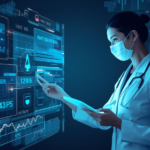Remote Patient Monitoring (RPM) has come a long way from simple blood pressure cuffs to sophisticated devices capable of tracking a wide array of health metrics. The latest Remote patient monitoring news highlights that 2025 is shaping up to be a milestone year for RPM technology, with innovations poised to expand monitoring capabilities beyond traditional vital signs to include glucose, respiratory health, and even early disease detection.
This evolution is transforming patient care, enabling proactive interventions, and providing healthcare providers with richer insights into patient health.
The Evolution of RPM Devices
Traditionally, RPM devices focused on monitoring basic vital signs such as blood pressure, heart rate, and weight. These devices were effective for chronic disease management and post-discharge monitoring but had limitations in scope and predictive capability.
Today, RPM devices have evolved to include:
-
Continuous Glucose Monitors (CGMs) for diabetes management.
-
Wearable heart monitors for arrhythmia and heart failure detection.
-
Pulse oximeters for oxygen saturation monitoring.
-
Smart inhalers and respiratory sensors for COPD and asthma.
These advancements allow healthcare providers to track complex health parameters remotely, improving patient outcomes and reducing hospital readmissions.
Glucose Monitoring Takes Center Stage
Continuous glucose monitoring is one of the fastest-growing segments in RPM. CGMs provide real-time insights into blood sugar levels, allowing both patients and clinicians to make immediate adjustments to diet, activity, and medication.
Recent Remote patient monitoring news highlights several developments:
-
Integration of CGMs with mobile apps for personalized alerts and trend analysis.
-
AI-driven analytics that predict glucose spikes or drops before they occur.
-
Remote physician dashboards that allow real-time interventions for high-risk patients.
CGMs are proving invaluable for diabetes management, reducing complications, and decreasing the likelihood of hospital visits.
Expanding Beyond Traditional Metrics
RPM devices are now exploring beyond blood pressure and glucose to capture new health metrics:
-
Respiratory Health Monitoring: Sensors embedded in wearables track oxygen levels, respiratory rate, and breathing patterns. These devices are especially valuable for patients with COPD, asthma, or post-COVID respiratory complications.
-
Cardiac Monitoring: Advanced ECG patches and smartwatches detect arrhythmias, heart failure indicators, and early signs of cardiac events. Continuous monitoring allows for timely interventions that can prevent hospitalizations.
-
Sleep and Stress Tracking: Wearables now monitor sleep quality, heart rate variability, and stress indicators, providing insights into mental and physical well-being that influence overall health.
-
Early Disease Detection: Experimental devices are being developed to track biomarkers in sweat, saliva, or interstitial fluids, potentially detecting infections, metabolic disorders, or even early-stage diseases before symptoms appear.
AI and Predictive Analytics in Next-Gen RPM
Artificial intelligence is a key driver of the next generation of RPM devices. By analyzing data from multiple sensors in real-time, AI algorithms can:
-
Predict potential complications before they occur.
-
Identify trends in chronic disease management.
-
Alert clinicians and patients to early warning signs.
For example, combining glucose trends with heart rate variability and activity data can help predict potential diabetic complications, enabling preventive interventions.
Integration with Telehealth
Next-generation RPM devices are increasingly integrated with telehealth platforms, allowing clinicians to:
-
Review real-time data during virtual consultations.
-
Adjust treatment plans based on continuous monitoring.
-
Communicate with patients proactively, rather than waiting for routine visits.
This integration strengthens continuity of care, improves patient engagement, and helps reduce hospital readmissions.
Benefits of Advanced RPM Devices
The expansion of RPM capabilities brings multiple benefits:
-
Improved Patient Outcomes: Continuous monitoring allows for early detection of complications and timely interventions.
-
Patient Empowerment: Access to real-time health data encourages patients to actively manage their health.
-
Reduced Healthcare Costs: Preventing hospitalizations and complications lowers overall system costs.
-
Enhanced Chronic Disease Management: Devices provide actionable insights for conditions like diabetes, heart failure, and COPD.
-
Proactive and Predictive Care: Advanced analytics enable clinicians to anticipate health issues before they become critical.
Challenges and Considerations
Despite these innovations, next-gen RPM devices face challenges:
-
Data Privacy and Security: Protecting sensitive health information remains paramount.
-
Device Costs: Advanced monitoring tools can be expensive, potentially limiting accessibility.
-
Patient Digital Literacy: Effective use requires patients to understand device operation and data interpretation.
-
Interoperability: Devices must seamlessly integrate with hospital electronic health records (EHRs) and telehealth platforms for maximum impact.
Addressing these challenges is essential for fully realizing the potential of advanced RPM technologies.
The Future of RPM Devices
Looking ahead, RPM devices will continue to expand in scope and sophistication:
-
Multi-parameter Monitoring: Devices will track multiple health metrics simultaneously, providing a holistic view of patient health.
-
AI-Driven Personalized Care: Predictive analytics will guide personalized treatment plans.
-
Wearable Miniaturization: Devices will become smaller, more comfortable, and unobtrusive, encouraging long-term adherence.
-
Remote Diagnostics and Early Detection: Biomarker monitoring may allow for early disease detection, shifting healthcare from reactive to preventive care.
These trends suggest that RPM will become a central component of patient-centered, data-driven healthcare.
Conclusion
The latest Remote patient monitoring news shows that RPM devices are evolving rapidly, moving from basic blood pressure monitoring to advanced glucose tracking, respiratory monitoring, and AI-driven predictive care.
As these devices become more sophisticated and integrated with telehealth and AI platforms, they are enabling proactive care, reducing hospital readmissions, and empowering patients to manage their health.
In 2025, the future of RPM lies in multi-parameter, predictive, and patient-centered monitoring—ensuring healthcare is not just reactive but proactive, personalized, and accessible.
Stay tuned for more such updates on Digital Health News.

